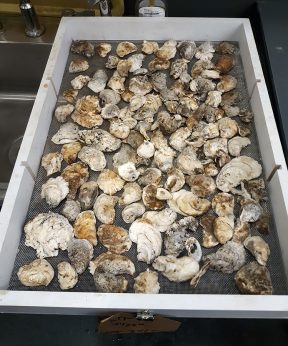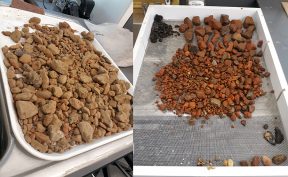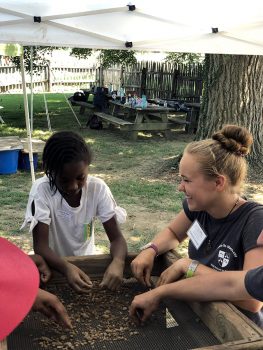Back to Dispatches from Field School
Field School 2019 – Week 8, Part 2
Kiley O’Haver — St. Mary’s College of Maryland
“Now We Teach What We Learned”
This week started on Tuesday with us starting to prepare for Tidewater Archaeology Weekend. This is an event held at Historic St. Mary’s City for public archaeology. The event allows the public to come and help screen soil to find artifacts. We started to hold soil back for this event; this meant not screening what we were digging for the week. On Wednesday we only dug half the day. In the afternoon we had a lecture from Charles Fithian. He was part of an excavation done in Delaware of a ship called the De Braak. This ship was a great find in telling the daily lives of sailors in the 18th century.
Thursday I was in the lab, working on washing artifacts with three other students from the field school. The morning was spent washing oyster shells from a previous archaeological dig. We had already finished the artifacts from the first part of this summer at the Mill Field. We ended up having five trays worth of oysters washed in three hours. Then after lunch, we learned how to label artifacts that have been washed and re-bagged. This is a process done so that the artifacts can be separated if needed and so they don’t lose their context, and therefore lose their importance. Following this we had new bags of artifacts come in from the Calvert House site to be washed. I washed the brick for most of the afternoon. The other students in the lab washed the lithics, or rock artifacts, glass, and ceramics. The picture below shows how the artifacts look coming into the lab and what they look like after being washed and sorted to make re-bagging easier.
Friday I was once again in the lab. This day I spent mostly dry brushing the metal artifacts that cannot get wet. I got to clean a shoe buckle, a lead shot, a button, and a copper penny. The penny is corroded, so you cannot see the year on it, but it has Lincoln on it and was majority copper, so it was from somewhere between 1909 and 1980. The button and other materials were most likely to be 17th century or 18th century. These artifacts also came from the Calvert House site.
Saturday and Sunday were Tidewater Archaeology Weekend. This event did not go entirely to plan with the heatwave this past week making the heat index 115 at points. We started our days outside with the public screening the backlog of soil we had created. But we closed site at 12:00pm both days due to the heat. Despite this, we still had roughly 100 people over the weekend come screen for artifacts with us. The team at the screen I was at found a Native American scraper (a tool for removing hair from an animal hide). The afternoon of both days was spent talking to the public about artifacts within the Visitor Center and the Shop at Farthings Ordinary. I enjoyed this weekend—being able to make other people excited about archaeology was a great experience.




